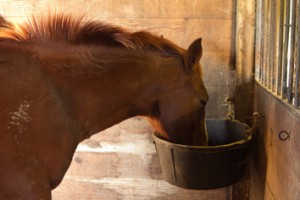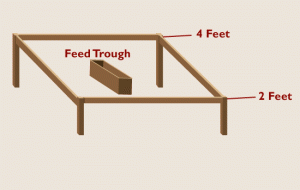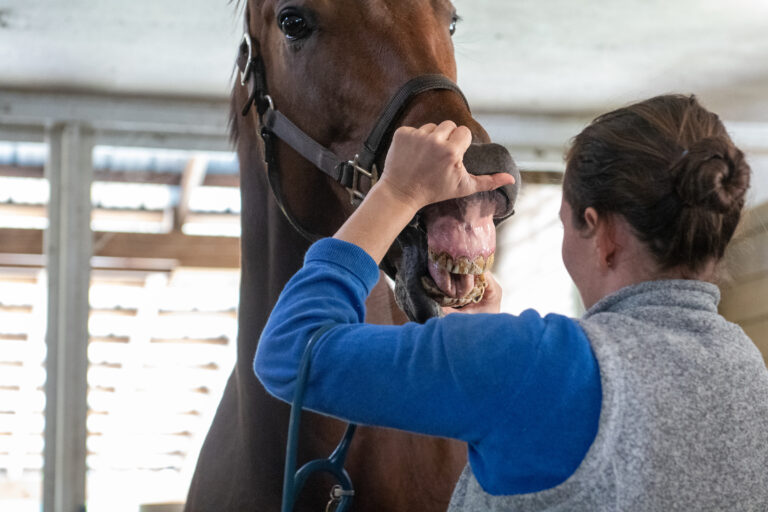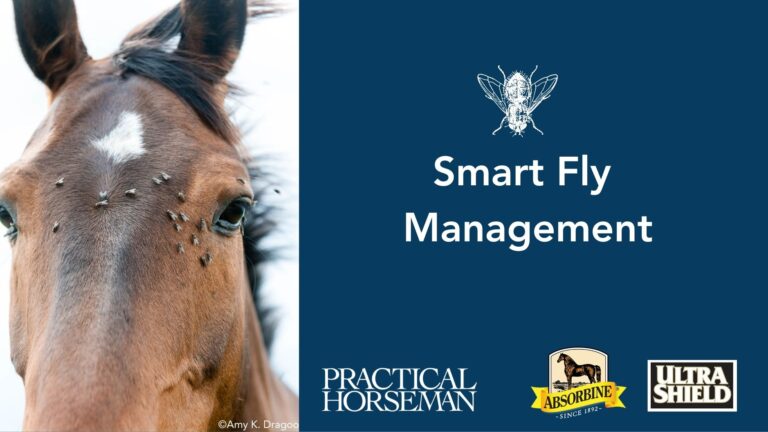Most foals are weaned at about 4 to 6 months, just when their nutritional needs begin to outpace their mothers’ milk supply. Designed to provide all of a foal’s nutritional needs at birth, a mare’s milk yield naturally starts to decline after the first month or two. By the time the foal is 4 months old, he must supplement his nursing with other food sources, such as forage (hay and pasture) and grain. Accustoming him to these nonmilk sources well before weaning time not only will help him maintain consistent growth throughout the transition, it will also help to avoid the “kid-in-the-candy-store” syndrome. In this situation, weanlings with no previous exposure to grain overeat, either ?because of the novelty of it or to compensate for previously inadequate nutrition.

Your foal will taste-test grass and hay as early as a few days old. But because the microorganism populations in newborns’ hindguts need several months to develop fully, he will have trouble digesting this forage initially. As he ?matures, his forage intake will increase and play a larger part in his diet. It’s important to continue encouraging his appetite for forage as he approaches weaning time. (A 4-month-old weanling should eat enough daily forage to equal between 0.5 and 1 percent of his body weight.) Think of him as a fussy toddler who won’t eat his vegetables unless they’re really tasty. Turn him out on a productive pasture or entice him with good-quality, palatable hay (fresh and clean, early-cut).
A growing foal requires high levels of protein, calcium and other minerals. After weaning, most horse owners provide some of this nutrition in the form of a concentrate balanced specifically for young horses. If you plan to feed your weanling grain, introduce him to it when he’s about 1 or 2 months old, starting with just a handful at a time and increasing the amount incrementally.
Introduce Grain
One good way to introduce nursing foals to grain is with a creep feeder: a four-sided, single-railed enclosure built either in the corner of the fence line or standing alone in the center of the pasture (the latter is preferable for group feeding, as it allows escape on all four sides). While mature horses are too big to duck under the rails, foals can come and go as they please. Young foals usually will take a few bites at a time and then return to their dams. This feeding method thus reduces the risks of digestive problems, such as colic and ulcers, brought on by large meals.

If you have only one foal, make the creep feeder sides about 8 feet long, set at your mare’s chest height. For each additional foal, add another 2 feet in length to each side. Space individual, shallow plastic, rubber or wood pans or troughs far apart and ?observe the group dynamics carefully to be sure that no foal is hogging the trough. Remember to ?remove excess feed daily to prevent spoilage.
If you don’t use a creep feeder, offer your foal small meals when his dam is being fed. He can eat out of her feeder?in which case, be sure the feed meets his nutritional needs, which are higher than the mare’s in some respects. (Many commercial dealers offer “mare-and-foal” concentrates, which work well in these circumstances.) If the mare doesn’t share well, feed your foal separately, either in an adjoining stall or just outside her stall (if it opens into a safe enclosure). Or mount a foal feeder, which has openings too narrow for an adult horse’s muzzle to access, for him on the wall of her stall.
After weaning, it’s easiest to regulate your foal’s grain ration by feeding him individually. However, if it’s more convenient to continue feeding him in a group, monitor his grain intake carefully. Without the option of his mother’s milk, he may be tempted to eat more grain than he needs. On the flip side, he may eat too little grain if other foals bully him away from it.

How Much?
How much you feed your weanling ?depends on how fast you want him to grow. A weanling on a primarily forage-only diet, for example, will experience a relatively slow growth rate, but will still reach full maturity eventually if the diet is properly balanced for energy, protein and minerals. Good-quality grass forage can be fed free choice (in unlimited amounts). However, if you are feeding a high-quality legume forage, such as early-mature alfalfa hay, you may need to restrict the hay to prevent the foal from getting fat.
To encourage what nutritionists call “optimal growth,” you can provide up to 60 percent of a weanling’s ration, based on weight, in the form of a concentrated feed designed specifically for growing horses. A good rule of thumb is about 1 pound of concentrate per 100 pounds of your foal’s body weight per day or 1 pound for each month of his age (for example, 4 pounds of grain per day for a 4-month-old), not exceeding about 7-9 pounds daily.
Encouraging even more rapid growth by feeding excessively large grain portions can contribute to long-term development problems, for example in the bones and joints, particularly in certain breeds, such as warmbloods and Quarter Horses. On the other hand, severely restricting rations or reducing protein levels in such horses’ diets has not been shown to reduce these orthopedic problems significantly. The best proven method for supporting healthy musculoskeletal growth is to provide a properly balanced diet??including plenty of forage?as well as unrestricted ?exercise, preferably in the form of 24-hours-a-day turnout.
Modify your weanling’s ration whenever necessary to keep his body condition score at about a 5. This means you can’t see his ribs but can easily feel them; there’s flesh over his back and hips but no deep crease down his back or fatty deposits around the tail; and his neck isn’t overly cresty. Be careful not to confuse a potbellied foal (with a bloated belly and no layer of fat over the ribs) with an overweight foal; a potbelly may indicate a parasite overload and/or poor hay quality, especially when accompanied by a poor hair coat.
Weanlings turned out in groups rarely get too fat, even when fed free-choice forage and given adequate concentrate to support growth. They expend a lot of energy playing with each other, while also developing strong musculoskeletal systems. Stalled youngsters, on the other hand, may overeat out of boredom and, without plenty of exercise, may become overly fat. To support the healthiest development, turn out your weanling as much as possible.
Your youngster will continue to build new bone and muscle until he is ?mature. Depending on his breed, that could be anywhere from 4 to 6 years old. Throughout that time, periodically reevaluate and adjust his diet to address his growing needs, as well as his exercise needs, until he reaches full maturity.
?
Dr. Christine Skelly is an associate professor and equine extension specialist at Michigan State University. She develops and teaches horse-management workshops and webinars on a variety of topics, including nutrition, facility management and manure management. She is also the founder and director of My Horse University (www.myhorseuniversity.com), an online source for horse-management courses produced by Michigan State University. Since its launch in 2006, My Horse University has provided nearly 1,000 courses to adult horse enthusiasts and high-school and college students.
This article originally appeared in the January 2011 issue of Practical Horseman magazine.











